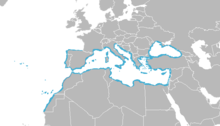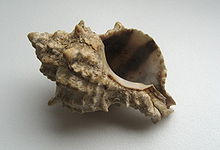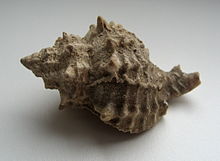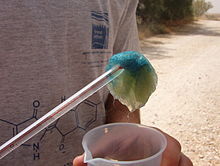- Hexaplex trunculus
-
Hexaplex trunculus 
Hexaplex trunculus 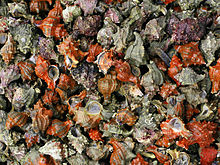
Hexaplex trunculus Scientific classification Kingdom: Animalia Phylum: Mollusca Class: Gastropoda (unranked): clade Caenogastropoda
clade Hypsogastropoda
clade NeogastropodaSuperfamily: Muricoidea Family: Muricidae Genus: Hexaplex Subgenus: Trunculariopsis[1] Species: H. trunculus Binomial name Hexaplex trunculus
Linnaeus, 1758Synonyms - Murex trunculus L. 1758
- Phyllanotus trunculus
- Truncullariopsis trunculus L., 1758
Hexaplex trunculus (also known as Murex trunculus or the banded dye-murex) is a medium-sized species of sea snail, a marine gastropod mollusk in the family Muricidae, the murex shells or rock snails.
This species of sea snail is important historically because its hypobranchial gland secretes a mucus that the ancient Canaanites/Phoenicians used as a distinctive purple-blue indigo dye. One of the dye's main chemical ingredients is indigotin, and if left in the sun for a few minutes before becoming fast, its color turns to a blue indigo (like blue jeans).
Contents
Distribution
This species lives in the Mediterranean Sea and the Atlantic coasts of Europe and Africa, specifically Spain, Portugal, Morocco, the Canary Islands, Azores.[1]
This murex occurs in shallow, sublittoral waters.
Shell description
Hexaplex trunculus has a broadly conical shell about 4 to 10 cm long. It has a rather high spire with seven angulated whorls. The shell is variable in sculpture and coloring with dark banding, in four varieties. The ribs sometimes develop thickenings or spines and give the shell a rough appearance.
Human use
Secretions from this species of snail were used as dye in ancient times. The snail itself is still used as a valuable food source in Portugal.[2]
As ancient dye
 Phoenician purple
Phoenician purple
The ancient method for mass-producing purple-blue dye from Hexaplex trunculus has not yet been successfully reproduced (because the purplish hue degrades too quickly, resulting in blue only). Nonetheless the use of this species in dyeing "purple-blue" has been confirmed in the archeology of Phoenicia, where large quantities of the shells have been recovered from inside ancient live storage chambers that were used for harvesting. Allegedly, 10-12,000 murex were needed to produce one gram of dye. The dye was highly prized in ancient times. Sometimes known as royal blue, it was prohibitively expensive and was only used by the highest ranking aristocracy.
A similar dye, Tyrian purple, which is purple-red in color, was made from a related species of marine snail, Murex brandaris. This dye (alternatively known as imperial purple, see purple) was also prohibitively expensive.
As dye in Judaism
The Hebrew Bible mentions a specific blue dye, called Tekhelet (Hebrew: תְּכֵלֶת, pronounced [təˈχeleθ]) for use in the Priestly garments as well in the layman's tzitzit, the formal tassels or fringes of clothing, which some believe refers to the indigo dye from the Hexaplex trunculus when kept in the sun.[3]
Similarly, the Hebrew Bible also mentions a specific purple dye, called argaman (Hebrew: אַרְגָּמָן [ʔaʁɡaˈman]), which refers to the purple color this same dye produces when kept in the shade.
That is, research by Otto Elsner (Shenker College of Fibers, Ramat Gan, Israel) and Ehud Spaneir (University of Haifa, Haifa, Israel) showed that by performing what is commonly referred to as "vat dyeing" based on the dyestuff from the trunculus, they could achieve colors varying from blue to purple depending on exposure to the sun when the dye solution was in its leuco (reduced) state. This phenomenon was attributed to the dyestuff being composed of indigo, mono-bromo-indigo and di-bromo-indigo.[citation needed] DiBromo-Indigo presents itself as purple whereas Indigo is blue. It was demonstrated that when the reduced solution of trunculus dye is exposed to sunlight, the UV-rays from the sun act to break the bromine bonds such that when oxidation occurs following the removal of the dyed fabric from the solution, pure indigo bonds to the wool, while the bromine atoms are left in the vat.
This feature of final color varying according to exposure to the sun was indeed known by the ancients, as noted in the writings of Vitruvius (1 c. BCE), “Purple exceeds all colors in costliness and superiority of its delightful effect. It is obtained from a marine shellfish. ...It has not the same shade in all the places where it is found, but is naturally qualified by the course of the sun”.[4]
See also
Notes
- ^ a b Houart, R.; Gofas, S. (2009). Hexaplex trunculus (Linnaeus, 1758). In: Bouchet, P.; Gofas, S.; Rosenberg, G. World Marine Mollusca database. Accessed through the World Register of Marine Species at http://www.marinespecies.org/aphia.php?p=taxdetails&id=140396 on 2010-05-05
- ^ Vasconcelos P., Carvalho S., Castro M. & Gaspar M. B. (June 2008) "The artisanal fishery for muricid gastropods (banded murex and purple dye murex) in the Ria Formosa lagoon (Algarve coast, southern Portugal)". Scientia Marina 72(2): 287-298. doi:10.3989/scimar.2008.72n2287
- ^ Ptil Tekhelet Organization
- ^ Vitruvius M. (1960) The Ten Books on Architecture. Dover Publications' New York, pp. x-331.
Further reading
- Radwin G. E. & D'Attilio A. (1986) Murex shells of the world. An illustrated guide to the Muricidae. Stanford University Press, Stanford, x + pp. 1–284 incl 192 figs. + 32 pls.
Categories:- Muricidae
- Fauna of Spain
- Animal dyes
Wikimedia Foundation. 2010.

